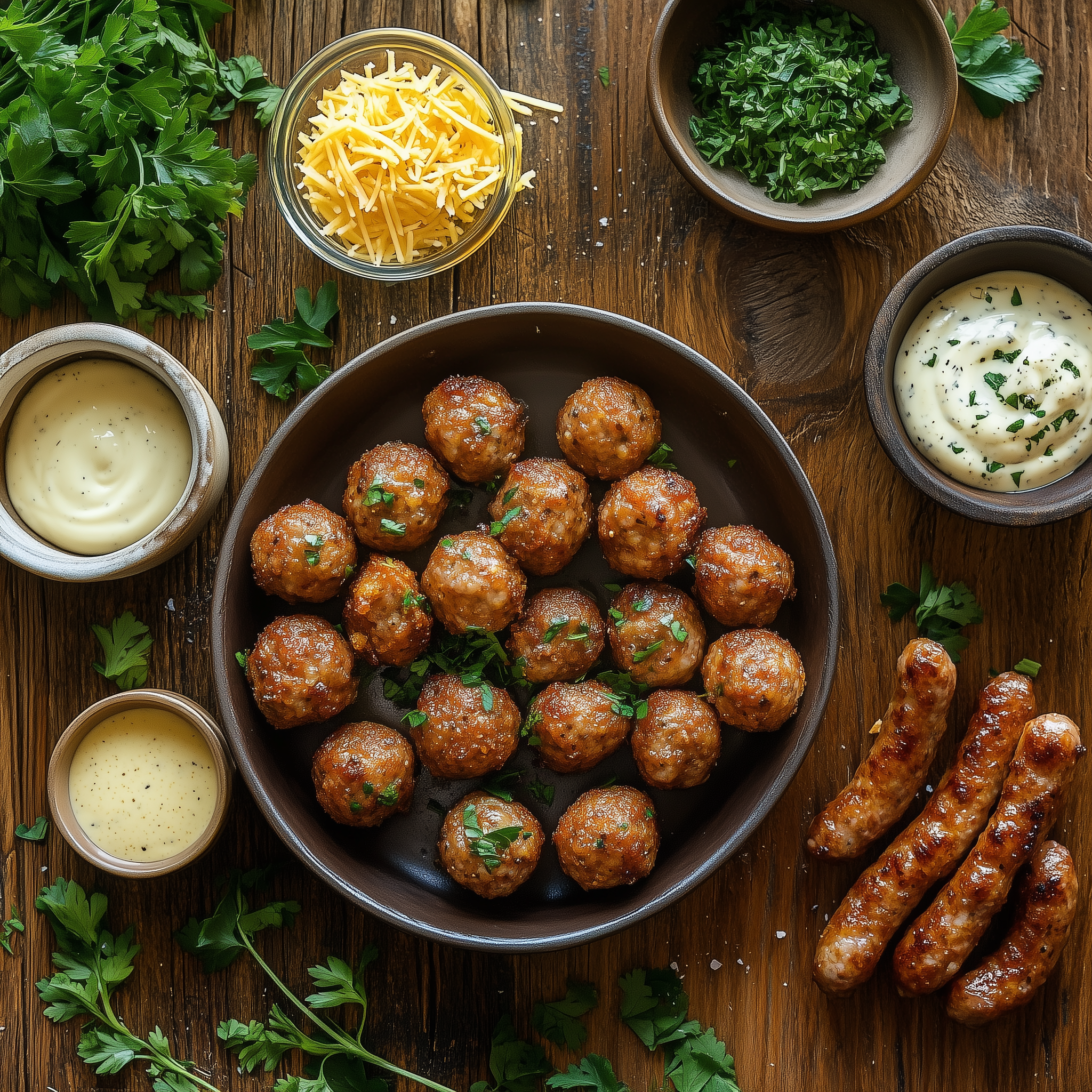introduction
Sausage balls have become a beloved treat worldwide, often enjoyed at parties, holiday gatherings, or as a quick snack. But what is the substance of sausage balls? Their appeal lies in a combination of rich flavors, easy preparation, and endless versatility. This article explores their origins, ingredients, and variations, providing insight into what makes these savory bites so unique.
The History of Sausage Balls
The origins of sausage balls are deeply rooted in Southern American cuisine, where resourceful cooks combined simple ingredients to create a crowd-pleasing dish. Initially, the focus was on convenience and using readily available ingredients like sausage, cheese, and flour. Over the years, their popularity grew, spreading across regions and evolving with diverse culinary influences.
What is the substance of sausage balls? Traditionally, they were a way to make use of pantry staples while providing a hearty, flavorful option for feeding a group. Today, these morsels symbolize comfort food and creativity, with recipes incorporating local flavors and seasonal ingredients.
Core Ingredients in Sausage Balls
What is the substance of sausage balls? At their core, they feature three key ingredients: sausage, cheese, and a binding agent. Each component plays a vital role in creating the texture and flavor.
- Sausage: Can be made with turkey, chicken, or plant-based alternatives.
- Cheese: Cheddar is the most common choice for its bold flavor, though mozzarella and vegan cheeses are also used.
- Binding Agent: Flour, breadcrumbs, or gluten-free alternatives keep the mixture cohesive.
Together, these elements form the substance of sausage balls, offering a satisfying balance of savory richness and texture.
The Role of Binding Ingredients
A crucial aspect of what is the substance of sausage balls lies in the binding ingredients. These ensure the sausage balls hold their shape during cooking while maintaining a tender bite.
Flour is the traditional binder, offering structure and absorbing excess moisture. Breadcrumbs are another popular choice, particularly for those who prefer a slightly softer texture. For individuals with dietary restrictions, almond flour or coconut flour provides excellent gluten-free alternatives.
The proper balance of binding ingredients is essential to achieving the perfect consistency. Too much can lead to dryness, while too little may result in the balls falling apart. Adjusting the proportions based on the type of sausage and cheese is key to mastering the art of crafting these treats.
Flavor Enhancers and Spices
One of the most exciting aspects of what is the substance of sausage balls is the flavor profile, enhanced by the addition of spices and seasonings. These ingredients transform a simple mixture into a dynamic and irresistible dish.
Common spices include:
- Paprika: Adds a subtle smokiness.
- Garlic Powder: Provides depth and aroma.
- Black Pepper: Balances richness with a hint of heat.
- Fresh Herbs: Parsley or thyme adds a vibrant freshness.
These spices not only enhance the flavor but also reflect regional variations and personal preferences. Whether you prefer a classic or bold twist, seasonings play an integral role in defining the substance of sausage balls.
Sausage Ball Preparation Techniques
Understanding what is the substance of sausage balls also involves knowing the best preparation methods. The right techniques ensure even cooking and an appealing texture.
- Mixing: Combine ingredients gently to avoid overworking the mixture.
- Shaping: Use a cookie scoop or roll the mixture by hand for uniformity.
- Cooking: Baking is the most common method, yielding a crisp exterior and tender interior. Frying offers an additional layer of crunch but requires careful attention to avoid greasiness.
These steps, when executed with care, highlight the substance of sausage balls by bringing out their best qualities—flavor, texture, and appearance.
Popular Sausage Ball Variations
The versatility of what is the substance of sausage balls allows for countless variations to suit any occasion or dietary need.
- Classic Southern Style: Pork sausage, sharp cheddar, and flour.
- Low-Carb Option: Sausage, almond flour, and mozzarella cheese.
- Holiday-Inspired: Add cranberries or pecans for a festive twist.
- Vegan Adaptation: Plant-based sausage, non-dairy cheese, and gluten-free binding agents.
Each variation showcases the adaptability of sausage balls, proving that their substance is more than just a combination of ingredients—it’s a reflection of culinary creativity.
Nutritional Information
For those curious about the health aspects of what is the substance of sausage balls, understanding their nutritional value is important. The specifics vary based on the recipe, but a general breakdown includes:
- Calories: Approximately 150-200 per serving (3 sausage balls).
- Protein: Around 8-10 grams, depending on the sausage and cheese.
- Fat: High in healthy fats, especially when using quality cheese and sausage.
- Carbohydrates: Minimal in low-carb versions, higher with traditional flour.
These bites can be adapted to meet dietary goals, ensuring that the substance of sausage balls aligns with individual preferences and health needs.
Sausage Balls in Modern Cuisine
What is the substance of sausage balls in contemporary cooking? Modern cuisine has elevated this humble dish, incorporating it into a variety of creative contexts. Sausage balls are now found in gourmet restaurants, fusion dishes, and even as a topping for salads and pizzas. Chefs experiment with unique ingredients like exotic cheeses, artisan sausages, and international spices to redefine their flavor.
These innovations demonstrate how the substance of sausage balls adapts to current culinary trends. They are often paired with complementary sauces such as sriracha aioli or maple mustard, enhancing their appeal. Whether served as an appetizer, a snack, or part of a larger dish, sausage balls hold their place in modern dining, blending tradition with contemporary flair.
External Influences and Adaptations
The question “What is the substance of sausage balls?” finds varied answers across the globe as this dish adapts to international cuisines. In Asia, sausage balls may include soy sauce and ginger for a savory umami twist. Mediterranean versions might feature feta cheese and sun-dried tomatoes, while Mexican adaptations often include chorizo and jalapeños.
These global interpretations show how the substance of sausage balls evolves to reflect local tastes and traditions. This adaptability ensures their relevance and popularity worldwide.
Making Sausage Balls for Special Diets
What is the substance of sausage balls for those with special dietary needs? With a few substitutions, sausage balls can be tailored to meet a variety of dietary restrictions.
- Low-Carb/Keto: Use almond or coconut flour instead of traditional flour.
- Vegetarian: Replace sausage with plant-based alternatives made from soy or jackfruit.
- Vegan: Combine vegan sausage, non-dairy cheese, and gluten-free flour for a completely plant-based option.
These modifications retain the essence of sausage balls while making them accessible to everyone.
Common Mistakes and How to Avoid Them
Knowing the essence of sausage balls is not just knowing the components. It requires knowing the common mistakes in preparation that affect their flavour, texture, and overall quality. With these guidelines and tricks, you will be able to create sausage balls that are tasty and visually attractive.
Mixing the ingredients The most frequent mistake is overmixing the sausage ball mix. While an efficient mixing process might be essential to a uniform texture, working the ingredients could produce dense, chewy sausage balls that are hard and chewy. To avoid this, gently fold the ingredients until they are incorporated. This ensures a smooth texture and evenly distributes the cheese, sausage, and binding agent.
Utilizing Too Much Flour: Adding excessive binding agents, like breadcrumbs or flour, can dry the sausage mixture and deprive the sausage balls of their moist, tasty bite. An appropriate mixture of ingredients is vital. Start with the suggested amounts of binding agent included in the recipe, then adjust just a bit if you need to. If your mixture feels too dry, add the milk in a small amount or a little more cheese, which may help restore the ideal consistency.
Baking in the incorrect temperature: Achieving perfectly cooked sausage balls requires attention to the temperature. Baking at a temperature too high will cause a scorch on the outside of the sausage, making the insides uncooked. In contrast, baking at a lower temperature can cause uneven cooking or a sloppy texture. Set your oven at a constant temperature of 375 degrees F for the best results, and you should consider rotating the baking sheets halfway through cooking to ensure an even distribution of heat.
If you can avoid these common mistakes to avoid these mistakes, you’ll be able to ensure that your sausage balls cook perfectly each time. Attention to the small details – whether mixing delicately and balancing ingredients and cooking to the proper temperature makes all the difference to creating a dish that’s just as satisfying to cook and enjoyable to eat.
Sausage Balls in Popular Culture
What is the substance of sausage balls in entertainment and media? These savory treats often make appearances in films, TV shows, and cookbooks, celebrated for their simplicity and crowd-pleasing nature. They are a favorite in Southern-themed events and have even inspired competitive cooking shows.
Their cultural significance lies in their ability to evoke nostalgia while serving as a canvas for culinary creativity. Whether spotlighted in a family dinner scene or a festive holiday spread, sausage balls symbolize comfort and community.
Where to Find the Best Sausage Balls
If you’re wondering, what is the substance of sausage balls when expertly prepared, many restaurants and bakeries offer standout versions. In the Southern United States, you’ll find traditional recipes made with authentic local sausage and sharp cheddar cheese. Meanwhile, modern eateries experiment with global flavors and upscale presentations.
For those who prefer homemade sausage balls, countless recipes are available online, allowing you to create your own perfect version tailored to your tastes. Whether dining out or cooking at home, these treats are always within reach.
FAQS
–What are sausage balls made of?
Sausage balls are made of a combination of sausage, cheese, and a binding ingredient like flour or breadcrumbs. These elements come together to create their signature flavor and texture. The sausage provides savory richness, while the cheese adds creaminess. The binding agent ensures the mixture holds its shape during cooking, making sausage balls a versatile and satisfying treat.
–What is the substance in summer sausage?
The substance in summer sausage is primarily a mix of ground meat, such as beef, pork, or venison, combined with curing agents, spices, and preservatives. These ingredients work together to create the sausage’s firm texture and distinct tangy flavor. Often smoked or fermented, summer sausage is designed to be shelf-stable, making it ideal for long storage and travel.
–What is the sausage made of?
Sausage is typically made of ground meat, such as pork, beef, or chicken, mixed with seasonings, spices, and sometimes fillers like breadcrumbs or rice. The mixture is stuffed into a casing, which may be natural (from animal intestines) or synthetic. This combination gives sausage its characteristic taste, versatility, and ability to complement a variety of dishes.
–What is the chewy stuff in sausage?
The chewy stuff in sausage often comes from connective tissues, cartilage, or improperly ground meat included in the sausage mixture. While these components are a natural part of meat processing, high-quality sausage minimizes their presence. Additionally, casings, especially natural ones, can contribute to a slight chewiness, which some people find adds to the overall texture and experience of the sausage.
Conclusion
What is the substance of sausage balls? It is a delightful blend of simple ingredients, rich history, and endless adaptability. From their origins in Southern kitchens to their place in modern cuisine, sausage balls continue to captivate with their flavor, texture, and versatility. Whether you’re enjoying a classic recipe or exploring innovative variations, these savory morsels remain a testament to the art of comfort food.

